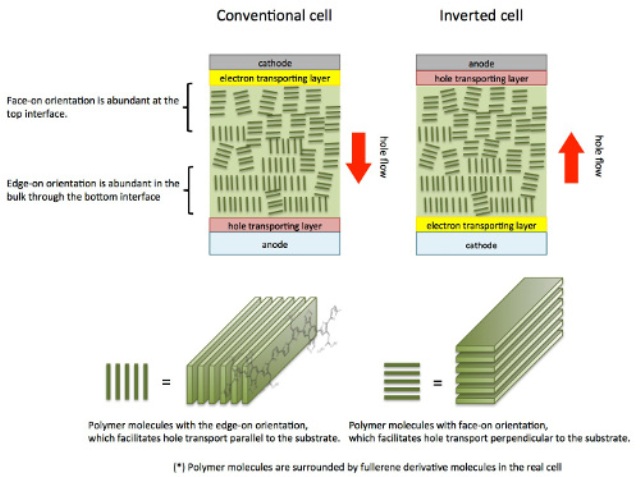May 26 2015
 Schematic illustrating the structure of the new solar cell
Schematic illustrating the structure of the new solar cell
A group of scientists from the RIKEN Center for Emergent Matter Science have developed a new type of polymer solar cell based on 'inverted' architecture and well-designed materials, which has an improved efficiency of 10%.
Polymer solar cells are widely being researched owing to their strong future capabilities and significant challenges. The lower production cost of these cells has made them a suitable replacement for traditional silicon substrate-based solar cells, with power conversion efficiencies of 10 to 15%.
In general, polymer solar cells provide numerous benefits. As they are made up of polymers, these cells are flexible, cheaper and can be laid on plastic or glass substrates. All these benefits allow scaling up the manufacture of polymer cells.
When compared to their silicon alternatives, the polymer solar cells are eco-friendly and inexpensive to manufacture. However, the major concerns associated with polymer cells are the ability to degrade rapidly and low power efficiency as a result of their structure.
The polymer solar cell developed was a bulk-heterojunction solar cell where the layers of electron donor and acceptor are combined together to achieve a power conversion efficiency of 10%, a range which is close to the threshold of commercial viability.
The research carried out jointly by Itaru Osaka and Kazuo Takimiya of the RIKEN Center was published in the Nature Photonics journal.
Osaka said, "While private firms have been able to develop cells with similar efficiency, they have done so using proprietary technology, so that it was not possible to know why things were working the way they were. We began experimenting with a substance called PNTz4T, which we had previously developed, and were able initially to achieve a power conversion efficiency of about 8%, with a fairly thick active layer of about 300 nanometers. Surprisingly, though, we found that when we used an inverted architecture, where the light enters through a transparent negative electrode, in our case made of zinc oxide, we found that the cell with the inverted architecture had better efficiency, which is abnormal for cells of the type we built. We believe that it is due to the alignment of molecules inside the mixed layers."
The analysis of the material's composition was carried out using the SPring-8 synchrotron facility in Harima. The molecular orientation in the active layer of the inverted model was commonly observed to be in "face-on" orientation that allows transport of electron holes via the material.
Takamiya said, "We surmised that this was the secret to the success in the experiment. It turns out that by trying something that might seem unusual, we got a surprising result, and through this were able to understand something about what makes cells more or less efficient."
Professor Hideyuki Murata of the Japan Advanced Institute of Science and Technology, who participated in the research, stated that, "This is an exciting result because we now have an understanding of how we can move forward to create polymer solar cells with greater efficiency. We hope that researchers around the world will be able to make use of these results to create commercially viable cells."
The research was carried out in association with the Japan Synchrotron Radiation Research Institute (JASRI), Hiroshima University and the Japan Advanced Institute of Science and Technology. The Japan Science and Technology Agency (JST) funded this research as a part of its Precursory Research for Embryonic Science and Technology program.